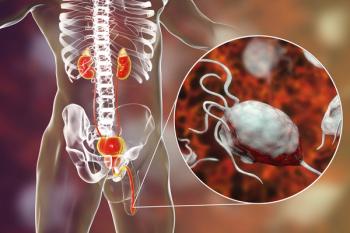
Salvage Nodal Radiation Shows Tolerability, Low Toxicity in Prostate Cancer
Imaging developments have made it possible to detect nodal recurrence at low PSA levels, which could help guide salvage approaches for prostate cancer.
Salvage nodal radiation therapy (SNRT) exhibited tolerability and low toxicity when treating patients with prostate cancer with nodal recurrence previously treated with radiotherapy, according to results from a retrospective, single-institution analysis presented at the
Results from the analysis revealed that after a median follow-up of 24.7 months (95% CI, 22.2-27.5) among 82 patients treated with SNRT, 1 grade 2 genitourinary (GU) toxicity occurred—an instance of noninfective cystitis—as well as 5 grade 2 gastrointestinal (GI) toxicities mostly consisting of diarrhea. Additionally, 1 late grade 3 GU toxicity occurred as well as 1 grade 2 GI toxicity.
Survival outcomes revealed that 96% (n = 79) of patients were alive at data cutoff, with 1 castration-resistant prostate cancer–related death observed and 2 non–prostate cancer deaths occurring due to myocardial infarction and Alzheimer disease, respectively. Furthermore, the median progression-free survival (PFS) was 35.6 months (95% CI, 32.6-63.7), with a greater proportion of patients with a Gleason sum of 6 to 7 free from progression vs those with a Gleason sum of 8 to 10.
“SNRT was well tolerated, with low toxicity and favorable early PFS. Advances in molecular imaging, such as PSMA [prostate-specific membrane antigen] PET, have made it possible to detect nodal recurrence at low prostate-specific membrane antigen levels, helping guide targeted salvage approaches,” Maheen A. Ansari, BS, research data coordinator in the Division of Radiation Oncology at MD Anderson Cancer Center, wrote in the presentation with study coninvestigators.1 “These findings support SNRT as a viable treatment for recurrent [prostate cancer] and are in line with findings from the PEACE-V (STORM) trial [NCT03569241], which showed benefit of [metastasis-directed therapy] in oligorecurrent disease.”2
The analysis included patients treated with SNRT between December 2018 and December 2024 for prostate cancer after having received prior radiotherapy. SNRT was delivered via volumetric modulated arc therapy, intensity-modulated radiation therapy, stereotactic body radiation therapy, or intensity-modulated proton therapy to PSMA/fluciclovine-avid or biopsy-positive nodes. Additionally, concomitant androgen deprivation therapy was given to 95% of patients.
Patients enrolled in the study additionally experienced nodal recurrence after prior radiation therapy with or without radical prostatectomy confirmed by PET-positive lymph nodes via PSMA or fluciclovine. A total of 31 patients had biopsy results–confirmed nodal recurrence.
Initial radiation therapy consisted of a median dose of 70 Gy (IQR, 70.0-73.5) across 35 fractions (IQR, 35-39), with radiation to nodes occurring in 17% of patients. SNRT was primarily done via full-chain nodal radiation therapy (89%), with a median dose of 61.6 Gy across 28 fractions. A total of 95% of patients received concurrent androgen deprivation therapy, with 63% of patients receiving it for 12 months or less.
Among patients treated in the study, the median age was 69 years (IQR, 65-74), and most patients had a histological confirmation of prostate cancer. A total of 70% of patients underwent prior radical prostatectomy, the median PSA level at diagnosis was 8.9 ng/ml (IQR, 5.7-16.0), and the most common initial diagnosis stages included T3a (22%), T1c (22%), T3b (16%), and T2b (10%). Additionally, most patients had N0 disease (75%) and high- (48%) or unfavorable intermediate-risk disease (27%) and had undergone imaging with PSMA or fluciclovine PET (93%).
The primary end point of the study was PFS, defined as from the initiation of SNRT to disease progression on imaging or last follow-up. Secondary end points included the incidence of GU/GI toxicities and prostate cancer–related mortality.
References
- Ansari MA, Hoffman KE, Mok H, et al. Clinical outcomes of salvage nodal radiotherapy for prostate cancer with prior radiotherapy. Abstract presented at: 2025 American Society for Radiation Oncology Annual Meeting; September 27-October 1, 2025; San Francisco, CA. Abstract 3186.
- Ost P, Siva S, Brabrand S, et al. Salvage metastasis-directed therapy versus elective nodal radiotherapy for oligorecurrent nodal prostate cancer metastases (PEACE V–STORM): a phase 2, open-label, randomised controlled trial. Lancet Oncol. 2025;26(6):695-706. doi:10.1016/S1470-2045(25)00197-4
Newsletter
Stay up to date on recent advances in the multidisciplinary approach to cancer.






















































































